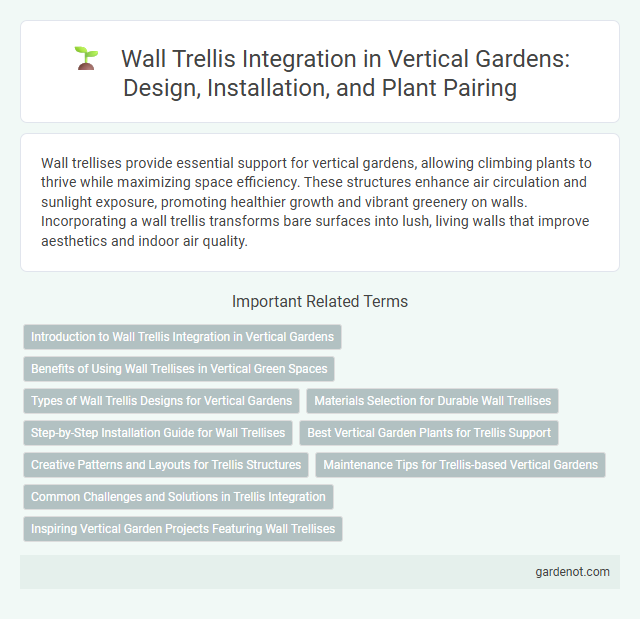Wall trellises provide essential support for vertical gardens, allowing climbing plants to thrive while maximizing space efficiency. These structures enhance air circulation and sunlight exposure, promoting healthier growth and vibrant greenery on walls. Incorporating a wall trellis transforms bare surfaces into lush, living walls that improve aesthetics and indoor air quality.
Introduction to Wall Trellis Integration in Vertical Gardens
Wall trellises serve as essential structural support in vertical gardens, enabling plants to climb and spread efficiently while maximizing limited space. These frameworks, often crafted from materials such as wood, metal, or plastic, enhance air circulation and light exposure, promoting healthier plant growth. Integrating wall trellises in vertical garden designs optimizes vertical space usage, making them ideal for both indoor and outdoor urban gardening.
Benefits of Using Wall Trellises in Vertical Green Spaces
Wall trellises enhance vertical garden designs by providing sturdy support for climbing plants, maximizing limited urban space. They improve air circulation around plants, reducing the risk of fungal diseases while promoting healthier growth. By adding aesthetic appeal and functional structure, wall trellises optimize green walls for both residential and commercial urban environments.
Types of Wall Trellis Designs for Vertical Gardens
Wall trellises for vertical gardens come in various designs including lattice panels, geometric grids, and modular systems, each supporting different plant types and growth habits. Wood, metal, and composite materials are commonly used, with choices affecting durability and aesthetic appeal in outdoor or indoor spaces. Adjustable and foldable trellises offer flexibility for seasonal planting and space management in compact urban gardens.
Materials Selection for Durable Wall Trellises
Wall trellises for vertical gardens require materials that balance durability with aesthetic appeal, such as cedar, redwood, or untreated hardwoods known for their natural resistance to rot and insects. Metal options like powder-coated steel or aluminum offer long-lasting strength and weather resistance, making them ideal for exposed outdoor environments. Selecting UV-resistant finishes or treatments enhances material longevity, preventing degradation from sun exposure and moisture.
Step-by-Step Installation Guide for Wall Trellises
Install a vertical garden wall trellis by first selecting a durable material like cedar or metal suited for outdoor conditions. Measure and mark the wall area, then securely anchor brackets using heavy-duty screws that can support the trellis weight and plant load. Attach the trellis framework to the brackets, ensuring stability and alignment, then guide climbing plants or vines along the structure, tying them gently to encourage vertical growth.
Best Vertical Garden Plants for Trellis Support
Wall trellises provide ideal vertical support for climbing plants like English ivy, jasmine, and clematis, which firmly attach and grow upward, maximizing space and aesthetic appeal. Passionflower and climbing roses also thrive on trellises, offering vibrant blossoms that enhance garden walls while ensuring healthy growth through proper foliage coverage. Selecting plants with strong tendrils or twining stems optimizes trellis use and creates a lush vertical garden that improves air quality and outdoor ambiance.
Creative Patterns and Layouts for Trellis Structures
Wall trellis structures for vertical gardens offer innovative options with creative patterns and layouts that enhance both aesthetics and plant support. Designs such as geometric grids, diagonal lattices, and asymmetrical shapes provide diverse frameworks for climbing plants, optimizing sunlight exposure and air circulation. Utilizing modular trellis panels allows customization of wall coverage, enabling dynamic and visually appealing green walls tailored to various architectural styles.
Maintenance Tips for Trellis-based Vertical Gardens
Regularly inspect the wall trellis for signs of rust, decay, or loose fittings to ensure structural integrity in vertical gardens. Clean the trellis with a mild detergent and water to prevent mold and algae buildup that can damage both the structure and plants. Prune climbing plants and adjust ties to avoid overgrowth, ensuring adequate air circulation and promoting healthy plant development on the trellis.
Common Challenges and Solutions in Trellis Integration
Wall trellis integration in vertical gardens often faces challenges such as structural instability, limited plant support, and inadequate spacing for growth. Using sturdy materials like treated wood or metal and ensuring secure wall anchoring can enhance stability, while adjustable trellis designs accommodate different plant sizes and growth patterns. Proper spacing and regular maintenance prevent overcrowding and improve air circulation, promoting healthier plant development.
Inspiring Vertical Garden Projects Featuring Wall Trellises
Wall trellises transform vertical gardens by providing structured support for climbing plants like ivy, clematis, and jasmine, enhancing both aesthetics and space efficiency. Innovative vertical garden projects use modular wall trellis systems made from durable materials such as cedar wood or powder-coated steel, offering customizable designs and promoting healthy plant growth. These trellises not only maximize greenery in limited spaces but also contribute to urban biodiversity and improve air quality.
Wall trellis Infographic

 gardenot.com
gardenot.com